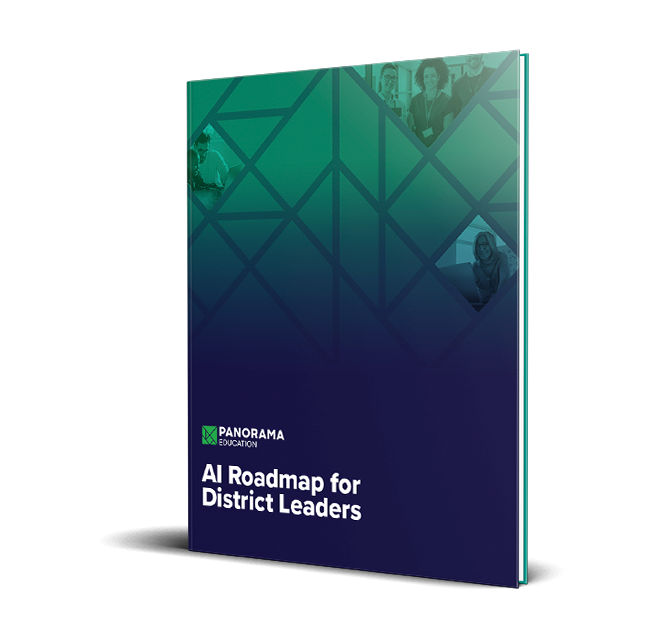Strong instruction. Proven interventions. Personalized support. District leaders know these are the levers of student success. The real question isn’t what works; it’s how to make it doable in every classroom, every day.
Even the best strategies can stall when systems lack the capacity to bring them to life. Closing that gap has long felt just out of reach. But today, it’s becoming possible.
A new generation of secure AI—built for the way educators work—is expanding capacity for schools, turning proven strategies into daily realities and helping districts sustain what’s working at scale.
Download our AI Roadmap for District Leaders
The Fidelity Gap
Every district invests heavily in strategies they trust, whether through high-quality instructional materials, literacy initiatives, MTSS frameworks, or student engagement programs. Yet teachers remain stretched thin. Principals juggle competing priorities. And district leaders see uneven results across schools despite shared goals.
This creates a fidelity gap: the persistent space between strategy and practice. Not for lack of will or expertise, but for lack of capacity. Until that gap is closed, students will continue to experience proven practices inconsistently.
Why Fidelity Still Falters in the Age of AI
Over the past year, schools have been flooded with new “AI for education” tools promising to solve everything from lesson planning to student support. But too many of these tools overlook what districts have spent years building.
They ignore established best practices, offering quick answers where thoughtful frameworks are needed. They generate Individualized Education Programs (IEPs) or intervention plans without student-specific data. They draft college recommendation letters without understanding the student’s actual record.
When AI is detached from data, systems, and educator insight, it risks undermining the very progress schools have made toward fidelity.
The solution isn’t more automation. It’s smarter integration—AI that works with existing systems, strengthens what educators already know works, and sustains proven practices with consistency and care.
From Best Practice to Real Impact With AI
District leaders don’t need more strategies. They need confidence that proven ones will take hold. That’s the shift now underway: from best practice to real impact—with AI.
Secure AI built the way educators work doesn’t replace expertise—it amplifies it. By surfacing insights in real time, guiding intervention planning, and supporting differentiated instruction, AI makes fidelity achievable at scale. What once felt impossible to sustain in every classroom can now become the norm.
Strategic Use Cases for Districts
Districts are already advancing ambitious priorities: adopting high-quality instructional materials, strengthening special education systems, implementing MTSS, improving attendance, and preparing students for postsecondary success. The challenge isn’t commitment. It’s consistency.
The next generation of AI is helping districts make these priorities sustainable by embedding fidelity into daily practice. Not by reinventing what works, but by making it easier to do what works at scale.
- High-Quality Instructional Materials (HQIM): Teachers can adapt rigorous content for individual learners in real time while maintaining alignment with core materials. AI helps educators identify where students are struggling and surface aligned supports.
- Special Education (SPED): AI can help staff track supports, monitor progress, and manage IEP follow-through—without losing sight of the individual student behind the plan. By bringing together data from multiple systems, educators can spend less time reconciling reports and more time on targeted support.
- Multi-Tiered System of Supports (MTSS): With AI-driven insights, teams can move from hours of data analysis to faster, more focused action. Surface-level trends become actionable signals, helping educators deliver interventions when they matter most, without compromising the professional judgment that drives every decision.
- Attendance & Engagement: Patterns of disengagement can be flagged early, allowing teams to intervene before absences become chronic. AI helps staff see patterns sooner so they can act faster. [Read more in our State of Chronic Absenteeism Report]
- College & Career Readiness: AI can help students explore post-secondary career options by synthesizing coursework, distinctions and CTE programs to understand how students' current pathway connects to potential career, vocational, or college options after graduation. [Explore our Graduation Tracking Toolkit]
These use cases signal a shift: AI isn’t redefining best practice. It’s helping districts sustain it. The goal isn’t to replace the human work of teaching and leading, but to make that work more consistent, supported, and sustainable.
What This Means for District Leaders
For district leaders, AI’s real promise is consistency—helping schools carry out the strategies they already trust. When implemented responsibly, it can make proven work more sustainable and bring fidelity within reach.
That shift means:
- Students benefit from evidence-based practices more consistently.
- Teachers spend less time on manual data tasks and more time building connections.
- Leaders can trust that priorities like MTSS, attendance, and literacy are being carried out with fidelity across schools.
This is the next phase of educational leadership: not chasing new strategies, but finally having the tools to sustain the ones that work.
Making What Works Sustainable With AI
For years, leaders have carried the tension between ambition and capacity—between knowing what students need and being able to deliver it consistently. Today, AI offers a way to resolve that tension.
This isn’t a distant vision. It’s happening in classrooms right now. The next generation of district leadership will be defined not by what we know works, but by how boldly we act on the tools that make it possible.





.jpg)

